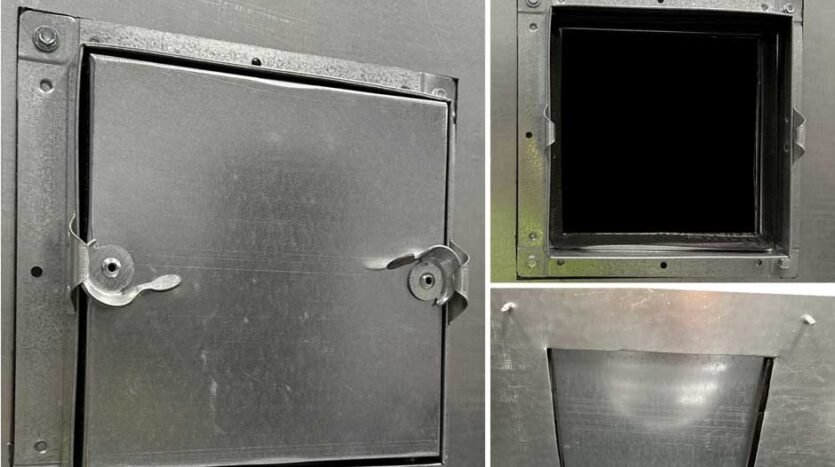Recessed Access Doors That Facilitate HVAC, Electrical, and Plumbing Work in Commercial Projects
For commercial contractors and maintenance teams, balancing easy access to building systems and a visually appealing environment can pose a problem. While access panels can keep systems like HVAC and plumbing hidden from plain sight, they can be an eyesore, particularly in lobbies and offices.
Recessed access doors are innovative solutions that combine practicality and aesthetics, enhancing the space while ensuring functionality. And while they’re often used in commercial spaces, the same principle applies at home—where clean lines, less clutter, and fewer disruptions to the living space make all the difference.
Let’s look at how these components contribute to commercial spaces.
How Recessed Access Doors Transform Spaces
Unlike traditional access doors that disrupt aesthetics, recessed access doors integrate into walls, ceilings, or floors. They provide easy access to HVAC, electrical, and plumbing systems while maintaining a clean appearance.
Recessed access doors are flush with the surface, enabling maintenance teams to reach essential building systems quickly. This design smartly blends practicality with a clean, stylish appearance.
Types of Recessed Access Doors for Mechanical, Electrical, and Plumbing (MEP)
Selecting the right door type depends on the materials and the specific needs of the HVAC, electrical, or plumbing system.
Two excellent choices for drywall finishing are mud-in flanges and drywall inlays. Mud-in flanges provide a clean, integrated appearance, while drywall inlays use matching drywall for a uniform look. Both options enhance interiors and reflect quality design.
In commercial applications, MEP systems may require specialized access doors:
- Gypsum Panel Doors: Lightweight and fire-resistant, gypsum panel doors ideal for fire-rated walls and ceilings.
- Metal Options (Steel and Stainless Steel): Steel doors offer strength and fire ratings, while stainless steel is best for damp areas due to its corrosion resistance.
- Round Panels: A discreet solution suitable for smaller access needs, providing discreet entry for junction boxes or valves.
The Benefits of Recessed Access Doors
Recessed access doors are an excellent choice for commercial contractors and maintenance teams.
A primary advantage is the prevention of potential damage. Technicians can easily access important valves or junction boxes without navigating bulky panels, minimizing the risk of harming walls or ceilings, which saves time and repair costs.
With simple latches, recessed doors can provide quick access to wiring, pipes, and ductwork, increasing productivity in busy schedules. They also protect essential systems by preventing dust and unauthorized access in high-traffic areas.
Expert Installation
When installed correctly, these access doors become seamless access points, improving their work and appearance. Proper framing is key. The rough opening must be the correct size and aligned with the wall or ceiling. This prevents gaps and ensures a smooth finish.
Before applying the final coat, always test-fit the access door to ensure it operates smoothly. The right tools, precise measuring instruments, sharp utility knives, and appropriate trowels matter. They will facilitate a clean, professional installation.
Keeping Access Easy
Once recessed access doors are installed, it’s up to maintenance teams to keep both the doors and the systems behind them in good shape. These panels may be subtle, but they play a key role in preserving the clean lines of a finished space—so knowing how to locate, open, and care for them matters.
To find these low-profile doors, teams should refer to as-built drawings or blueprints whenever possible. It also helps to be familiar with the door’s opening mechanisms. Some recessed panels use push-to-open latches, while others rely on concealed locks. Knowing how to handle each type gently reduces the risk of damage during routine checks.
When it comes to cleaning, panels should be treated just like the surrounding surface. Whether the finish is painted drywall or plaster, careful cleaning around the edges helps avoid peeling or chipping.
And if a door sticks or won’t open properly, it’s better to call in support than to force it. A little patience can go a long way in preventing avoidable repairs.
Choosing the Right Panel
Selecting the right recessed access doors is essential for the functionality and appearance of your commercial project. Here are key factors to consider:
- Application: Identify the MEP system needing access. Ensure electrical work fire ratings are met. For plumbing, opt for a stainless-steel door to prevent rust, and check insulation options for HVAC systems.
- Location: Consider where the access door will be placed. Different locations may require different latch types, such as a push latch for ceilings or a keyed lock for walls in less secure areas.
- Wall or Ceiling Material and Finish: Match the door to the wall or ceiling material for a seamless look. A drywall finish may need a mud-in or drywall inlay panel, while plaster requires a panel with a plaster bead flange.
- Required Opening Size: Ensure the opening is adequately sized for maintenance access to systems behind the wall or ceiling. A too-small opening defeats the purpose of accessibility.
- Security Needs: Assess security requirements. Sensitive areas may need a cylinder lock, while less critical locations can use simpler latches.
- Building Codes and Ratings: Check building codes and fire ratings to ensure compliance. Confirm that the access door meets necessary standards and has certification for its ratings.
- Budget: Think about your budget. Recessed access doors are a long-term investment. While they might cost more initially, they offer better looks and lower upkeep costs over time.
Final Thoughts
Standard access panels can detract from your project’s appearance. Recessed access doors are a better option, offering straightforward entry to HVAC, electrical, and plumbing systems. Commercial spaces gain improved aesthetics and better functionality by using these panels.


